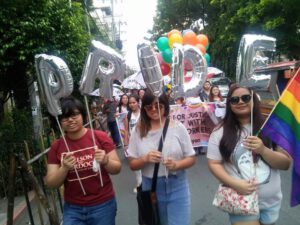We have seen the stronghold of the LGBT community when rainbow flag and banner-carrying members marched side by side with their supporters last Saturday, June 27. With the news of legalizing same-sex marriage in all 50 states in the United States (US), ask any Filipino and that person will say that the fight is not yet over.
“Two decades after the first LGBT Pride March in the country and in the whole Asia Pacific in 1994, we are still subjected to the horrors of discrimination and homophobia,” said Murphy Red, national president of Kapederasyon LGBT sectoral organization.
He explained that these problems are deeply rooted in centuries-old colonialism which had set off a patriarchal culture among Filipinos.
“Exploitation and persecution against LGBTs has persisted. We are taken advantage of during traditional political campaigns. We are always portrayed as the laughing stock in movies and television shows. We are also subjected to hate crimes which often result in injury or death of our members,” he said.
The long-time activist, whose short story appeared in Ladlad anthology, also underscored the need for an economic and political structure geared towards the needs of the LGBT community.
“Our lives have gotten worse. Beauty parlors and other jobs that involve manual labor only offer pitiful wages. We are slapped with discriminatory job standards and treated as dispensable members of the labor force,” he said.
Feudal and heteronormative or heterosexual viewpoints and traditions on sexual relations also affect LGBTs at their workplaces.
About 15 to 43 percent of gays and lesbians experience discrimination and harassment in offices and factories where they work. An alarming 90 percent of transgender workers and employees experience maltreatment and violence at their workplaces.
The research study of Dr. Anthony Cordero, from the University of the Philippines Manila Center for Gender and Women’s Studies, entitled “Gender Issues and Problems in the Workplace” reported discrimination against both women and LGBT workers.
 About 15 to 43 percent of gays and lesbians experience discrimination and harassment in offices and factories where they work. An alarming 90 percent of transgender workers and employees experience maltreatment and violence at their workplaces. These situations set physical, social, and economic risks faced by LGBTs.
About 15 to 43 percent of gays and lesbians experience discrimination and harassment in offices and factories where they work. An alarming 90 percent of transgender workers and employees experience maltreatment and violence at their workplaces. These situations set physical, social, and economic risks faced by LGBTs.
Isis International-Manila, an international feminist organization, reported in 2010 that transgender workers earn 10 to 32 percent less compared to their heterosexual counterparts, based from their qualifications. There is also a high rate of transexuals who are unable to find work.
Another glaring practice in the country, according to Red, is that LGBT members are only accepted inside their own homes if they will shoulder all the expenses of their families.
“The financial support of LGBTs tantamount to buying our legitimacy so we could get accepted as members of their families. Some of us are not allowed by their families to marry, build a family, and have children. LGBTs are forced by their families to pay for their house rent, electricity, water, school expenses of their younger siblings, and needs of older relatives,” he said.
Red’s organization has recorded various hate crimes against the LGBT community in the country.
 “For instance, in January 2012, a 19-year-old Filipino gay man suffered severe burns when his own father threw boiling water over him. In March 2013, a second year high school student in Batangas took his own life because he was bullied by his classmates,” he related.
“For instance, in January 2012, a 19-year-old Filipino gay man suffered severe burns when his own father threw boiling water over him. In March 2013, a second year high school student in Batangas took his own life because he was bullied by his classmates,” he related.
According to Philippine LGBT Hate Crime Watch, there are 164 cases of LGBT members who were killed between 1996 to June 2012. This year saw the death of Jennifer Laude at the hands of US Marine Lance Corporal Joseph Scott Pemberton. There are many other undocumented cases of murder because police records did not identify them as related to the victims’ sexuality.
Red also pointed out other situations where our culture reflects how we see the LGBT community.
“Because of patriarchism and heteronormativity, fathers prefer siring lesbian daughters than gay sons. LGBT members are also forced to adapt stereotypes, like gays constrained to become beauticians or lesbians constrained to become security guards, as an instinctive mechanism for survival,” he said.
LGBT members are also victims of commodification. They have to invest on their beauty and intelligence just to build a relationship with the people who are well-to-do so they could escape poverty.
“Every Filipino LGBT has to participate to ensure opportunities for employment, ownership of tilled land, attain just and living wage, and develop national industries. The struggle of the LGBT community is not separate from the struggle of the people. We have to organize our sector,” he said.
When LGBT members build relationships among themselves, what most people describe as “lasunan” is actually a concrete expression of breaking the chains based on power relations.
“Every Filipino LGBT has to participate to ensure opportunities for employment, ownership of tilled land, attain just and living wage, and develop national industries. The struggle of the LGBT community is not separate from the struggle of the people. We have to organize our sector,” he said.
Photo courtesy of Kapederasyon and Leanne Jazul/rappler.com
[masterslider id=”35″]






























